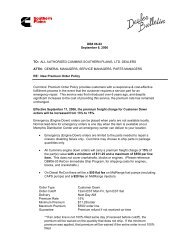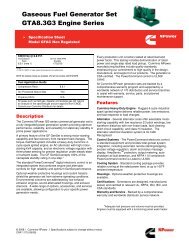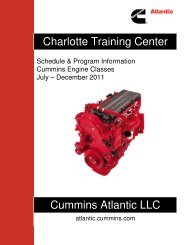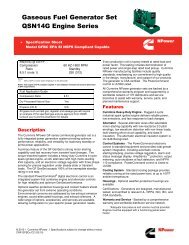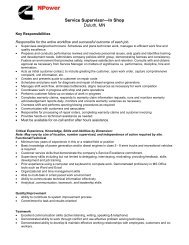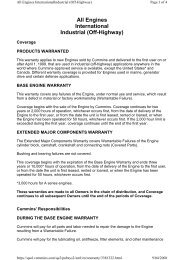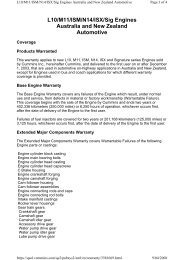LONG
Cummins Commentary
Cummins Commentary
- No tags were found...
You also want an ePaper? Increase the reach of your titles
YUMPU automatically turns print PDFs into web optimized ePapers that Google loves.
12<br />
EVERY<br />
UPDATE<br />
Cummins has a strong presence at Darwin airport. These two<br />
PowerBox generator sets provide back-up power for the terminal<br />
and other civil facilities in the airport precinct.<br />
lights<br />
Darwin airport<br />
the way<br />
Darwin airport is an official emergency<br />
landing site for the Space Shuttle.<br />
The most impressive arrival you<br />
could possibly make at Darwin<br />
International Airport is by the<br />
Space Shuttle.<br />
With its long runway — 3.35 km long by 60 metres wide<br />
— the airport is an official emergency landing site for the<br />
NASA space craft.<br />
Darwin International Airport is actually a joint-user facility<br />
shared with the Department of Defence. The site has been<br />
a base for the Royal Australian Air Force since 1940 and<br />
today is one of the RAAF’s main forward operating bases.<br />
The airport can accommodate the largest aircraft<br />
operating in the world today.<br />
Emergency back-up power is thus critical at the airport,<br />
especially with Darwin having one of the highest lightning<br />
strike rates in the world. Early this year, the city was<br />
blacked out for around 10 hours after a lightning strike.<br />
Cummins has a strong presence at the airport, its<br />
generator sets used for emergency back-up power at both<br />
defence and civil facilities. Air Traffic Control is provided<br />
by the RAAF, with the control tower having a 330 kVA<br />
Cummins diesel genset on standby to provide critical<br />
power in the event of a grid outage.<br />
The domestic/international terminal with its computer<br />
and public address systems, flight arrival/departure<br />
monitors, security cameras, air conditioning, apron<br />
lighting and so on also relies on uninterrupted<br />
electrical service.<br />
“Darwin is very vulnerable during the wet season because<br />
of lightning strikes, so the airport must have a reliable<br />
back-up power system,” says Quentin Parker, technical<br />
services manager at the airport.<br />
Two Cummins PowerBox 40X diesel generator sets, each<br />
rated at 1.5 MW, provide back-up power for the terminal<br />
and other civil facilities in the airport precinct which<br />
include two hotels with a third under construction.<br />
The PowerBox concept provides a fully integrated power<br />
system with the genset installed in an ISO container — a<br />
40 ft container in the case of the units at Darwin airport.<br />
These gensets are powered by the Cummins QSK60, a<br />
60-litre V16.<br />
“Darwin International Airport wanted a quick, simple<br />
and competitively priced solution to their increased<br />
emergency power demand and we were able to provide<br />
that solution,” says Wayne Smith, who headed up the<br />
project for Cummins Darwin.<br />
Two 70,000-litre diesel tanks and a 3,500-litre day tank<br />
give the gensets the capacity to run 24/7 for around<br />
a week.<br />
Darwin airport’s technical services manager Quentin<br />
Parker (left) with Nic Plovits and Wayne Smith from the<br />
Cummins Darwin branch.<br />
Emergency back-up power is critical at the airport,<br />
especially with Darwin having one of the highest<br />
lightning strike rates in the world.<br />
Powered by 11<br />
Eleven<br />
Cummins engines<br />
Cummins engines are installed<br />
in this ship-and-barge combination<br />
— the Ursa Montana — which is 192.5<br />
metres long and operates on 800 km<br />
of the River Rhine in Europe.<br />
The ship is 104.5 metres long with<br />
a beam of 17.28 metres, while the<br />
95-metre long barge — secured to<br />
the bow of the mother vessel — has<br />
the same 17.28-metre beam.<br />
When the two vessels’ combined<br />
length is too long for a lock, the<br />
barge and ship are decoupled.<br />
Utilising thrusters, the barge<br />
(navigated from a small wheelhouse<br />
forward) can enter the lock under its<br />
own power. The main vessel can then<br />
transit the lock before rejoining<br />
the barge.<br />
To perform these aquatic manoeuvres<br />
requires five 560 hp Cummins QSX15<br />
thruster engines and two 1,800 hp<br />
Cummins QSK50 main engines. In<br />
addition to these seven engines,<br />
four Cummins QSB-powered 85 kVA<br />
generator sets provide electrical<br />
power to the two vessels.<br />
Total installed power is 6,727 hp.



